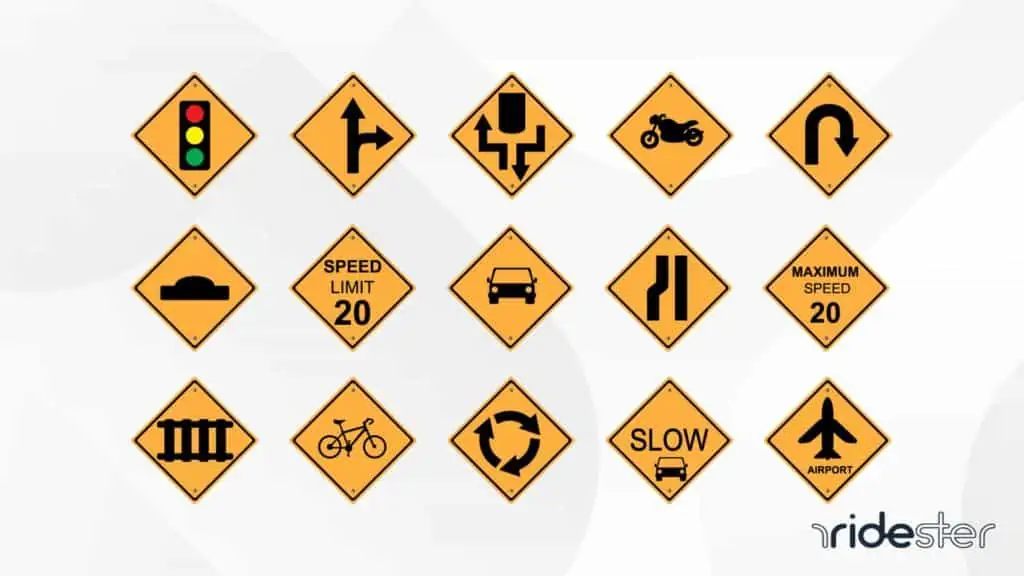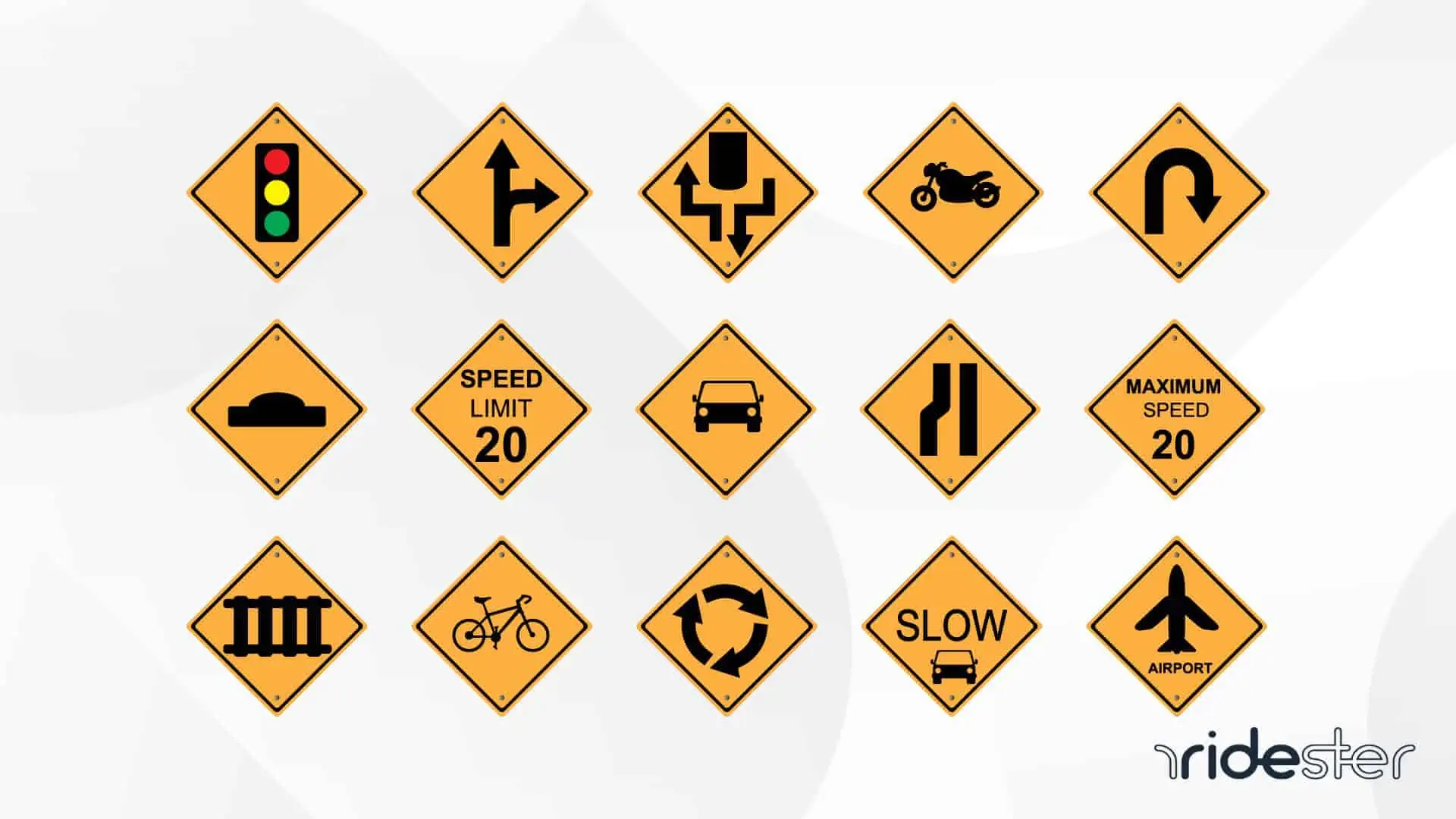Key Takeaways
- Review guides, sign information, FAQs, and tips to pass the road signs test on the first attempt.
- road signs test, conducted by the DMV, is a crucial step towards earning a driver’s license.
- Practice with free online tests and study sheets to ensure quick and accurate sign recognition.
- Consider enrolling in a test prep course for structured learning and to boost your chances of passing.
What is a Road Signs Test?

A road signs test is a written exam. A state licensing department or division conducts the exam.
Many know the department by its more popular moniker, the DMV (Department of Motor Vehicles).
While the name differs in some states, there is an equivalent institution in all states.
For example, Alabama, Georgia, Iowa, and Arizona have a Motor Vehicle Division (MVD).
Most road signs tests consist of 25 multiple-choice questions.
Each question includes a sign image accompanied by four descriptions, and the goal is to choose the correct description.
For example, an image of an orange diamond-shaped sign depicting a person with a shovel might trigger the following description:
- Construction ahead
- Pedestrian crossing
- Yield
- None of the above
After selecting “construction ahead,” the answer is marked as correct, and the applicant proceeds to the next question.
However, the test will automatically end prematurely if the percentage of incorrect answers is greater than correct answers.
While it can vary from state to state, the average DMV written test requires a score of 80% or higher to pass.
For example, in California, applicants need to answer 20 out of 25 questions correctly to pass.
Suggested: Road Signs and Their Meanings
Why Might You Need a Road Signs Test?
A road signs test is the first step to acquiring a driver’s license for the first time.
Passing this test grants a learner’s permit from the state, qualifying you for a behind-the-wheel or CDL exam for a complete driver’s license.
With a learner’s permit, you drive on all public roads and highways while accompanied by an adult who has obtained a full driver’s license.
You qualify for a driving or road test once you hold a learner’s permit for 180 days.
For drivers under 18, the license includes restrictions, such as passenger allowances and ages.
If your learner’s permit expires before acquiring an intermediate driver’s license, you will need to retake the road signs test.
The 3 Types of Road Signs
There are three main categories you need to know for your road signs test.
1. Regulatory Signs
Regulatory signs state regulations, rules, or conditions that drivers must obey.
Examples include “Do Not Enter” or “Wrong Way” signs.
Drivers can recognize regulatory signs by white writing on a red background.
There are also white background signs featuring a red circle with a line through it.
For these types, the image depicts a prohibited action.
For example, if the sign pictured a right-angled arrow, that would indicate drivers can’t turn right.
2. Warning Signs
Warning signs caution drivers about something ahead.
Animal crossings, winding roads, and sharp curves are examples of this type of sign.
As hazards and road conditions are the primary subjects, warning signs are eye-catching yellow with bold images or black lettering.
Typically, the shape is diamond, but drivers will also see similar shapes, such as a square or rectangle.
3. Guide Signs
Guide signs help drivers navigate the area.
From simple street signs to mile markers, guide signs tell drivers what’s ahead and how to get where they need to go.
The shapes and colors of guide signs vary, depending on what the sign indicates.
However, most guide signs will have a rectangular or square shape.
Green is the most common color for guide signs, but drivers will also see white or blue guide signs.
The writing is usually white, with exceptions, such as black writing on a white background.
3 Ways to Prepare for a Road Signs Test
Preparing the right way for your road signs test is possible with three simple methods.
1. Road Signs Test Study Sheet (Free)
Before you can start studying for your road signs test, you need access to the correct information.
You don’t need to scramble to Google or flip through an official manual with a study sheet.
All you need to know is in one place.
Use this free study sheet to start reviewing.
2. Traffic & Road Sign Test (Free)
Practice makes perfect, and with free online tests, you can practice until recognition becomes a reflex.
If you’re a nervous tester, it can be helpful to simulate the testing environment.
For example, you might try a few practice tests at a library or other public space with Wi-Fi access.
A public space can help simulate some of the unpredictable distractions and help you practice your concentration.
Check out this link for a free road signs test.
3. Buy a Test Prep Course (Paid)
A test prep course is another excellent way for rapid learning.
It allows preppers access to up-to-date information and additional resources.
It’s also helpful if you’re having trouble organizing time to study or if you lose concentration while reviewing.
Not only does a paid-for course offer an obvious incentive to pay attention, but it also creates an environment that allows you to focus on learning.
Click to link for a fantastic resource for a test prep course.
The site also offers a free road signs practice test.
Tips for Passing a Road Signs Test
Whatever preparation method you rely on, there are tips that everyone can use to improve their score.
It starts with practicing good habits.
Here are four tips for passing your road signs test.

1. Study Ahead of Time
Cramming is the worst way to study, as it often results in forgetting.
Instead, you should study ahead of time.
It’s best if you go over your signs guide more than once.
Evidence shows that information and skill retention improve when we review twice or more.
Give yourself plenty of time to read guides and use practice tests.
2. Create the Right Study Environment
Discovering the best environment for studying can be personal, but there are a few themes everyone needs.
Classical music has been a cliché go-to for background music, but you might find a different genre helps you focus.
Complete silence is rarely the right way to go.
It’s best to simulate the same distraction level you’d expect when writing an exam.
3. Come Prepared
Coming prepared is about more than stuffing your brain with sign knowledge.
You need the right amount of rest and fuel in your system to present your best self—plan to show up about 10 minutes before your road signs test.
Then, if you’re on time, rested, and energized, you remove any obstacles that might block your success.
If you require accommodations or proper corrective lenses, prepare before your test.
4. Don’t Overthink It
While reviewing in advance of your exam date will help you pass the first time, sometimes nerves get the better of us.
When you overthink it, your brain might draw a blank.
You’ve studied ahead of time, and you’ve utilized a few practice tests.
Calm down and carefully look over the questions.
Relax and do your best.
Frequently Asked Questions
What are blue signs called?
Blue signs serve as guides, indicating services for road users, tourist information, and evacuation routes. A prominent example is the interstate sign, featuring a blue background, white numbers, and a red stripe at the top, displaying states’ names, directions, and route numbers.
What are road signs green?
Green road signs are used for direction and permitted movements, featuring white writing. They include mile markers, street, exit, toll road, and logo service signs, providing guidance before reaching a destination or directing towards a location.
What lane is for slow drivers?
The right lane is generally considered for slower drivers, as road etiquette and some state laws designate the left lane for passing or faster traffic.
While there’s no specific “slow lane,” slower drivers are expected to use the right lane, adhering to speed limits rather than significantly slowing down traffic. The left lane is for speedier travel, with drivers encouraged to keep right if not passing or turning left.
Wrapping Up
No one likes tests, but you can make it easier by preparing the right way.
First, start by knowing the main sign types, as it can help you recognize a sign’s purpose, even if you don’t remember every sign. Then, take advantage of free online tests and study sheets.
Have you tried any of our tips? Which works best for you? Try them all, and you’ll be prepared for your road signs test and become a safer driver.





